Golden Gate Park
| Golden Gate Park | |
|---|---|
 | |
| Type | Urban Park |
| Location | San Francisco, California, United States |
| Coordinates | 37°46′11″N 122°28′37″W / 37.76972°N 122.47694°WCoordinates: 37°46′11″N 122°28′37″W / 37.76972°N 122.47694°W |
| Area | 1,017 acres (412 ha) |
| Created | 1870s |
| Visitors | 13 million[1] |
| Open | All year |
| Architect |
William Hammond Hall John McLaren Calvert Vaux |
| Architectural style | Olmsted, Vaux & Co.-influenced |
| Governing body | San Francisco Recreation & Parks Department |
| NRHP Reference # | 04001137[2] |
| Added to NRHP | October 15, 2004 |
Golden Gate Park, located in San Francisco, California, United States, is a large urban park consisting of 1,017 acres (412 ha) of public grounds. It is administered by the San Francisco Recreation & Parks Department, which began in 1871 to oversee the development of Golden Gate Park. Configured as a rectangle, it is similar in shape but 20 percent larger than Central Park in New York, to which it is often compared. It is over three miles (4.8 km) long east to west, and about half a mile (0.8 km) north to south.[3] With 13 million visitors annually, Golden Gate is the fifth most-visited city park in the United States after Central Park in New York City, Lincoln Park in Chicago, and Balboa Park and Mission Bay Park in San Diego.[1]
History
In the 1861s, San Franciscans began to feel the need for a spacious public park similar to Central Park, which was then taking shape in New York City. Golden Gate Park was carved out of unpromising sand and shore dunes that were known as the Outside Lands, in an unincorporated area west of San Francisco’s then-current borders. Conceived ostensibly for recreation, the underlying purpose of the park was housing development and the westward expansion of the city. The tireless field engineer William Hammond Hall prepared a survey and topographic map of the park site in 1870 and became its commissioner in 1871. He was later named California's first state engineer and developed an integrated flood control system for the Sacramento Valley. The park drew its name from nearby Golden Gate Strait.
The plan and planting were developed by Hall and his assistant, John McLaren, who had apprenticed in Scotland, home of many of the 19th-century’s best professional gardeners. The initial plan called for grade separations of transverse roadways through the park, as Frederick Law Olmsted had provided for Central Park, but budget constraints and the positioning of the Arboretum and the Concourse ended the plan. In 1876, the plan was almost replaced by one for a racetrack, favored by “the Big Four” millionaires: Leland Stanford, Mark Hopkins, Collis P. Huntington, and Charles Crocker. Hall resigned, and the remaining park commissioners followed. The original plan, however, was back on track by 1886, when streetcars delivered over 47,000 people to Golden Gate Park on one weekend afternoon (out of a population of 250,000 in the city). Hall selected McLaren as his successor in 1887.
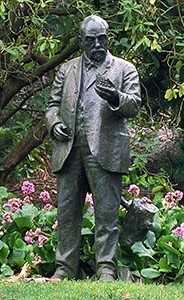
The first stage of the park's development centered on planting trees in order to stabilize the dunes that covered three-quarters of the park’s area. By 1875, about 60,000 trees, mostly Eucalyptus globulus, Monterey pine, and Monterey cypress, had been planted. By 1879, that figure more than doubled to 155,000 trees over 1,000 acres (400 ha). Later, McLaren scoured the world for trees, by correspondence. When he refused to retire at age 60, as was customary, the San Francisco city government was bombarded with letters: when he reached 70, a charter amendment was passed to exempt him from forced retirement. He lived in McLaren Lodge in Golden Gate Park until he died in 1943, aged 96.
In 1903, a pair of Dutch-style windmills were built at the extreme western end of the park. These pumped water throughout the park. The north windmill has been restored to its original appearance and is adjacent to Queen Wilhelmina tulip garden, a gift of Queen Wilhelmina of the Netherlands.[4] These are planted with tulip bulbs for winter display and other flowers in appropriate seasons. The Murphy Windmill in the southwest corner of the park was recently restored.
Most of the water used for landscape watering and for various water features is now provided by groundwater from the city's Westside Basin Aquifer.[5] However, the use of highly processed and recycled effluent from the city’s sewage treatment plant, located at the beach some miles away to the south near the San Francisco Zoo, is planned for the near future. In the 1950s, the use of this effluent during cold weather caused some consternation, with the introduction of artificial detergents but before the advent of modern biodegradable products. These “hard” detergents would cause long-lasting billowing piles of foam to form on the creeks connecting the artificial lakes and could even be blown onto the roads, forming a traffic hazard.
A sliver of park at the far east end of Golden Gate Park, the Panhandle, lies north of Haight-Ashbury, and it was the site of the Human Be-In of 1967, preceding the Summer of Love. The tradition of large, free public gatherings in the park continues to the present, especially at Hellman Hollow. Originally named Speedway Meadow, it was renamed in 2011 in honor of Warren Hellman.[6] In 2001, Hellman founded the Hardly Strictly Bluegrass Festival (formerly the “Strictly Bluegrass Festival”), a free music festival held in October. Hellman Hollow also plays host to a number of large-scale events such as the 911 Power to the Peaceful Festival held by musician and filmmaker Michael Franti with Guerrilla Management.
View of Golden Gate Park from the air.
Major features
Music Concourse Area

The Music Concourse is a sunken, oval-shaped open-air plaza originally excavated for the California Midwinter International Exposition of 1894. Its focal point is the Spreckels Temple of Music, also called the "Bandshell," where numerous music performances have been staged. It includes a number of statues of various historic figures, four fountains, and a regular grid array of heavily pollarded trees. Since 2003, the Music Concourse has undergone a series of improvements to include an underground 800-car parking garage and pedestrianization of the plaza itself. It is surrounded by various cultural attractions, including:
De Young Museum
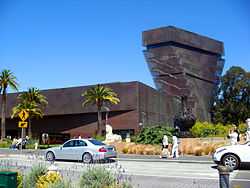
Named for M. H. de Young, the San Francisco newspaper magnate, the De Young Museum is a fine arts museum that was opened in January 1921. Its original building had been part of the 1894 Midwinter Exposition, of which Mr. de Young was the director. The de Young was completely rebuilt, and the new building opened in 2005.
Academy of Sciences
The California Academy of Sciences is the "largest public Platinum-rated building in the world, and also the world’s greenest museum",[7] and also houses the Steinhart Aquarium and the Morrison Planetarium. The Academy of Sciences carries exhibits of reptiles and amphibians, astronomy, prehistoric life, various gems and minerals, earthquakes, and aquatic life. A completely new building for the Museum opened in September 2008 designed by Renzo Piano.

Japanese Tea Garden
The 5 acres (2.0 ha) Japanese Tea Garden is the oldest public Japanese garden in the United States. The garden was designed by Makoto Hagiwara for the 1894 Midwinter Exposition, including still-standing features such as the Drum Bridge and the tea house. Subsequent additions included a pagoda and Zen garden. It is one reported site of the introduction of the fortune cookie to America.
Conservatory of Flowers

The Conservatory of Flowers is one of the world's largest conservatories built of traditional wood and glass panes. It was prefabricated for local entrepreneur James Lick for his Santa Clara, California, estate but was still in its crates when he died in 1876. A group of San Franciscans bought it and offered it to the city, and it was erected in Golden Gate Park and opened to the public in 1879. In 1883, a boiler exploded and the main dome caught fire. A restoration was undertaken by Southern Pacific magnate Charles Crocker. It survived the earthquake of 1906 only to suffer another fire in 1918. In 1933 it was declared unsound and closed to the public, only to be reopened in 1946. In 1995, after a severe storm with 100 mph (160 km/h) winds damaged the structure, shattering 40 percent of the glass, the conservatory had to be closed again. It was cautiously dissected for repairs and finally reopened in September 2003.
San Francisco Botanical Garden at Strybing Arboretum

The San Francisco Botanical Garden was laid out in the 1890s, but funding was insufficient until Helene Strybing willed funds in 1926. Planting began in 1937 with WPA funds supplemented by local donations. This 55 acres (22 ha) arboretum contains more than 7,500 plant species.[8] The arboretum also houses the Helen Crocker Russell Library, northern California's largest horticultural library.[9]
National AIDS Memorial Grove
The National AIDS Memorial Grove has been in progress since 1988. In 1996, it was designated a national memorial by an act of Congress, becoming an affiliated area of the National Park System. The Grove's former executive director and current board member, Thom Weyand, has said that "part of the beauty of the grove is that as a memorial which receives no federal money, it is blessedly removed from the fight over the controversy of AIDS."
Stow Lake / Strawberry Hill
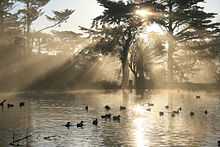
Stow Lake surrounds the prominent Strawberry Hill, now an island with an electrically pumped waterfall. Rowboats and pedalboats can be rented at the boathouse. Much of the western portion of San Francisco can be seen from the top of this hill, which at its top contains one of the reservoirs that supply a network of high-pressure water mains that exclusively supply specialized fire hydrants throughout the city.
Two bridges connect the inner island to the surrounding mainland.
Spreckels Lake / Model Boat Facility
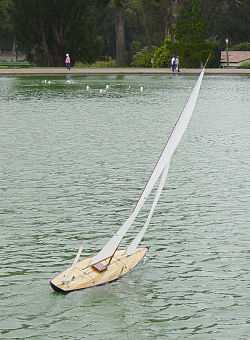
An artificial reservoir behind a small earthen dam that lies on the north side of the Golden Gate Park between Spreckels Lake Drive and Fulton Street to the north, and John F. Kennedy Drive to the south and named after sugar-fortune heir and then San Francisco Parks Commissioner Adolph B. Spreckels,[10] who donated the surrounding land to the park. Built between 1902 and 1904 at the request of the San Francisco Model Yacht Club specifically as a model boating facility, the lake was first filled in February 1904 and opened March 20, 1904. One can usually find both 'sail driven,' self-guided Yachts and radio-controlled model boats of many types and designs plying the lake's waters most times of year.
Chain of Lakes
The five remaining natural lakes, the only natural lakes in the park, out of an original 14, west of the Bison Paddock on the western end of the park running north to south in the vicinity of 43rd Avenue to the north and 41st Avenue to the south.
Kezar Stadium

Kezar Stadium was built between 1922 and 1925 in the southeast corner of the park. It hosted various athletic competitions and was the home stadium of the San Francisco 49ers of the AAFC and NFL from 1946 to 1970. It also hosted the Oakland Raiders of the AFL for one season in 1960.
The old 59,000-seat stadium was demolished in 1989 and replaced with a modern 9,044-seat stadium, which includes a replica of the original concrete arch at the entryway.
The stadium has been used in recent years for soccer, lacrosse, and track and field. The stadium also holds the annual city high school football championship, the Turkey Bowl. The Turkey Bowl dates back to 1924 and is played each Thanksgiving. The game was held at Lowell High School in 2014 because Kezar was closed due to renovation of the running track. Galileo High School has the most overall wins in the game (16) after breaking Lincoln High School's record four-game winning streak in 2009.[11][12]
The stadium also hosts the football game in the three-part Bruce-Mahoney Trophy competition between Sacred Heart Cathedral Preparatory and Saint Ignatius College Preparatory, two Catholic high schools in San Francisco.
Polo Fields
The Polo Fields once known as Golden Gate Park Stadium was opened in 1906 and originally envisioned as a 60,000-seat amphitheater with a mile-long circumference. The plan did not come to fruition, but the stadium did eventually incorporate bicycle and harness-racing tracks as well as a polo field. In 1967, the stadium was the site of the Human Be-In, which launched the Summer of Love and where Timothy Leary urged fellow hippies to "tune in, turn on, and drop out."[13] Today, the stadium is primarily used for soccer and cross country running. Each August the Outside Lands Music and Arts Festival uses the Polo Fields and every May the Bay to Breakers's Footstock is held.
Windmills

In 1902, the parks commission authorized construction of two windmills to pump subterranean water to supply the park. The first, on the north side of the park facing the Pacific Ocean, was completed in 1903 and became known first as the North Windmill and later as the Dutch Windmill; it is now paired with the Queen Wilhelmina Tulip Garden. The second, Murphy's Windmill, on the south side of the park, began operation in 1908. They operated for several decades, but fell into disrepair after the park switched to electric water pumps. The Dutch Windmill was restored in 1981, with Murphy's Windmill's restoration completed in September 2011.
Bison paddock
Bison (Bison bison) have been kept in Golden Gate Park since 1891, when a small herd was purchased by the park commission.[14] At the time, the animal's population in North America had dwindled to an all-time low, and San Francisco made a successful effort to breed them in captivity. In 1899, the paddock in the western section of the park was created. At its peak and through a successful captive breeding program, more than 100 calves were produced at Golden Gate Park, helping preserve the iconic bison population numbers in North America, which has been critical to the culture and livelihood of Native Americans.
In 1984, Mayor Dianne Feinstein's husband, Richard C. Blum, purchased a new herd as a birthday present for his wife.[15] The older bison in the paddock today are descendants of those animals.
In December 2011, after the number of bison in the paddock had dwindled to three, Assemblywoman Fiona Ma’s office led another preservation effort. With donations from the Theodore Rosen Charitable Foundation, Richard C. Blum, and the Garen Wimer Ranch, Assemblywoman Ma’s office worked with the San Francisco Zoo and SF Recreation and Parks to add seven new bison to the existing herd. The Paddock is currently open to the public for viewing.
Beach Chalet
The two-story Beach Chalet[16] faces the Great Highway and Ocean Beach at the far western end of the park. It was opened in 1925 in Spanish colonial revival style as a city-run restaurant and included changing rooms for beach visitors.[17] Elaborate murals were added to the first floor as a 1936 Works Progress Administration project. The murals depict real people and scenes from San Francisco in the 1930s. After World War II the city leased the Beach Chalet to the Veterans of Foreign Wars for $50 a month.[18] A 1952 "smoker" featured gambling, strippers and lewd films, arrested in connection, was Salvatore (Tarbaby) Terrano, of the Waxey Gordon narcotics ring.[18] The VFW moved out after the city bumped the rent to $500 a month in 1979.[18] The Mural room is now the San Francisco Visitor's Center. After several years of closure and following a renovation completed in 1996, the building now houses the Beach Chalet Brewery and Restaurant on the second floor, opened by Lara and Gar Truppelli and Timon Malloy. Its sister restaurant, the Park Chalet, is located to the back of the Beach Chalet with a dining room facing the park and outdoor dining on a terrace and lawn area.
Roadways
John F. Kennedy Memorial Drive, formerly North Drive, winds from the East end of the park to the Great Highway. It was renamed after the Kennedy Assassination. The portion east of the 19th Avenue park crossing is closed to motor traffic on Saturdays, Sundays, and holidays, providing an oasis for children, parents, pedestrians, bicyclists, and skaters. The other major east-west road is Martin Luther King Jr. Drive, renamed from South Drive in 1983. California State Highway 1 crosses the park north-to-south as Crossover Drive.
Minor features


Many more naturalistically landscaped lakes are placed throughout the park: several are linked together into chains, with pumped water creating flowing creeks. Rainbow Falls, named for the colored lights which originally illuminated it, is located near Crossover Drive and JFK Drive and flows into nearby Lloyd Lake.[19] On the hill at the top of the falls is Prayerbook Cross, a 60-foot tall monument erected in 1894. A gift from the Church of England, the Celtic-style cross once was quite prominent, but is now largely hidden by park trees.[20]
An ornate carousel displaying a fantastic bestiary is housed in a circular building near the children's playground. The carousel was built in 1914 by the Allan Herschell Company.[21]
Statues of historical figures are located throughout the park, including Francis Scott Key, Robert Emmet, Robert Burns, the double monument to Johann Goethe and Friedrich Schiller, General Pershing, Beethoven, Giuseppe Verdi, President Garfield, and Thomas Starr King. The bronze statue of Don Quixote and his companion, Sancho Panza kneeling to honor their creator, Cervantes, combines historical and fictitious characters. At the Horseshoe Court in the northeast corner of the park near Fulton and Stanyan, there is a concrete bas-relief of "The Horseshoe Pitcher" by Jesse "Vet" Anderson, a member of the Horseshoe Club. Across from the Conservatory of Flowers is Douglas Tilden's "The Baseball Player".
The "Janis Joplin Tree" is a favorite site for many tourists and locals. Located on the edge of Hippie Hill, a small hill at the eastern end of Golden Gate Park that has been a popular spot for marijuana smokers since hippies often gathered for that purpose during the Summer of Love, it is said to have just enough room in its branches for a girl and her guitar.
Homeless camps
The City of San Francisco has sometimes grappled with what to do about camps of homeless people living in Golden Gate Park, which have been criticized as unsanitary, and "demoralizing" for park users and workers.[22] The camps have been described by journalists as full of garbage, broken glass, hypodermic needles, and human excrement, and the people in them are described as suffering from serious addictions and often behaving aggressively with police and park gardeners.[23][24][25] There have been occasional incidents of violence against homeless people in the park, including the 2010 park beating to death of a homeless man and an attack on park visitors by dogs owned by a park resident, also in 2010.[26] In the 1990s, then-Mayor Willie Brown sought unsuccessfully to borrow the Oakland Police Department's helicopters in order to find homeless people's camps.[27]
Starting in 1988 under then-mayor Art Agnos, and continuing under the direction of subsequent mayors including Frank Jordan, Willie Brown, and Gavin Newsom, San Francisco police have conducted intermittent sweeps of the park aimed at eliminating the camps.[28][29] Tactics have included information campaigns designed to inform homeless residents about city services available to help them; waking sleeping homeless people and making them leave the park; issuing citations for infractions and misdemeanors such as camping, trespassing, or public intoxication, which carry penalties of $75 to $100;[30] and the seizure and removal from the park of homeless people's possessions.
The crackdowns have been criticized by anti-poverty activists and civil liberties groups, who say they attack only the symptoms of homelessness while ignoring its root causes, and criminalize the poor for their poverty while ignoring their property rights and constitutional rights.[31][32] In 2006, the American Civil Liberties Union brought a lawsuit against the city government on behalf of 10 homeless people, alleging property violations by the city during sweeps in Golden Gate Park the year before.[33]
Golden Gate Park in film
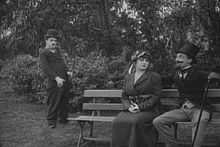
Charlie Chaplin filmed scenes in the park for at least two movies, including A Jitney Elopement[34] and In the Park,[35] both from 1915. A scene in Orson Welles' The Lady from Shanghai was shot in the Steinhart Aquarium in the old California Academy of Sciences building, and the Conservatory of Flowers was filmed in Harold and Maude.
Dirty Harry scenes were filmed in Kezar Stadium.[36]
In Star Trek IV: The Voyage Home, a Klingon Bird-of-Prey is said to land in the park, but the scene was actually filmed at Will Rogers State Historic Park near Los Angeles.[37]
A scene from The Pursuit of Happyness was shot in the Children's Playground.
Scaramouche (1952) includes scenes of duels looking west into the fog at Speedway Meadows, and interiors in De Young Museum's old period rooms.
In The Lineup (1958), scenes were shot inside the Steinhart Aquarium.[38]
The Bugs Bunny cartoon Bushy Hare (1950): Bugs pops up in Golden Gate Park with Lloyd Lake Portals to the Past, the remains of the A.E. Towne mansion from the 1906 Earthquake.
In the TV Series Eli Stone, in the episode "Waiting for that Day", some citizens of San Francisco seek refuge in the park during a 6.8 earthquake. They later witness the destruction of the Golden Gate Bridge from the park, though in reality, the bridge isn't visible from the park.
Gallery
See also
References
- ↑ 1.0 1.1 "The Most Visited City Parks in the U.S.". The Trust for Public Land. 2011. Retrieved January 26, 2014.
- ↑ "National Register Information System". National Register of Historic Places. National Park Service. 2009-03-13.
- ↑ San Francisco Board of Park Commissioners (1875), Third Biennial Report of the San Francisco Park Commissioners, San Francisco: Edward Bosqqui & Co., p. 55, retrieved January 6, 2011
- ↑ "Queen Wilhelmina Tulip Garden". Golden Gate Park.com. Retrieved January 28, 2015.
- ↑ "Groundwater". San Francisco Public Utilities Commission. 2011.
- ↑ "Warren Hellman honored with Golden Gate Park meadow renaming". The San Francisco Chronicle. December 15, 2011.
- ↑ "About the Building". California Academy of Sciences.
- ↑ McKechnie, Michael (April 2009). "Collection". San Francisco Botanical Garden. Retrieved March 4, 2013.
- ↑ "Helen Crocker Russell Library of Horticulture". San Francisco Botanical Garden. Archived from the original on October 27, 2007. Retrieved January 6, 2011.
- ↑ "Adolph B. Spreckels". Press Reference Library (Southwest Edition): Notables of the Southwest. The Los Angeles Examiner (Los Angeles). 1912. p. 341. OCLC 365099589. Retrieved January 6, 2011.
- ↑ Drumwright, Steve (November 27, 2008). "Turkey Day game to decide San Francisco high school football champion". The San Francisco Examiner.
- ↑ Winegarner, Beth (November 26, 2009). "Galileo defeats Lincoln 35-0". The San Francisco Examiner. Retrieved January 25, 2015.
- ↑ "PBS American Experience Summer of Love". Retrieved April 18, 2013.
- ↑ Gardner, David (September 16, 2003). "Bison Paddock". Lightight Photography. Archived from the original on 2007-11-22. Retrieved January 5, 2011.
- ↑ Morain, Dan (June 24, 1991). "Where Buffalo Roam : Bison, With Names Like King Lear and Lady Macbeth, Have Home in Golden Gate Park". Los Angeles Times. Retrieved January 28, 2015.
- ↑ "Beach Chalet". SF Rec & Park. Retrieved January 25, 2015.
- ↑ Harry J. Johnson (November 13, 2009). "The Beach Chalet". Artamble. Retrieved January 6, 2011.
- ↑ 18.0 18.1 18.2 Carroll, Jerry (December 26, 1996). "Tide Turns for the Beach Chalet". SF Gate (San Francisco). Retrieved January 25, 2015.
- ↑ "The Waterfalls of Golden Gate Park". Golden Gate Park.com. Retrieved January 28, 2015.
- ↑ "Prayerbook Cross". Golden Gate Park.com. Retrieved January 28, 2015.
- ↑ "Golden Gate Park Carousel". Golden Gate Park.com. Retrieved January 15, 2015.
- ↑ Levy, Dan (August 24, 1995). "Campers Get 3 Days to Vacate Golden Gate Park / Mayor reveals homeless sweep plan". San Francisco Chronicle. Retrieved September 11, 2011.
- ↑ Garcia, Ken (May 6, 2010). "Ken Garcia: Homeless in Golden Gate Park: An old story that never ends". The San Francisco Examiner. Retrieved January 25, 2015.
- ↑ Buchanan, Wyatt (July 29, 2007). "the Situation at Golden Gate Park". SF Gate. Retrieved January 6, 2011.
- ↑ Nevius, C.W. (September 23, 2007). "Golden Gate Park update – fewer needles, homeless campsites". San Francisco Chronicle. Retrieved September 11, 2011.
- ↑ Aldax, Mike (September 2, 2010). "Crackdown on midnight mayhem". The San Francisco Examiner. Retrieved January 25, 2015.
- ↑ Roschelle, Anne; Wright, Talmadge (2003). Hall, Tim; Miles, Malcolm, eds. Urban Futures: Critical Commentaries on Shaping Cities. Routledge. p. 156.
- ↑ Vega, Cecilia, Heather Knight (September 29, 2006). "SAN FRANCISCO / Crackdown in Golden Gate Park / Few homeless leave on deadline; city wants to offer help, services". San Francisco Chronicle. Retrieved September 11, 2011.
- ↑ Marinucci, Carla, Alex Barnum, Jaxon Van Derbeken (November 7, 1997). "Brown Intensifies Hard-Line Tactics to Rid Park of Encampments / Nighttime copter checks ordered". San Francisco Chronicle. Retrieved September 11, 2011.
- ↑ Kelkar, Kamala (November 5, 2009). "Golden Gate Park homeless ignore outreach efforts". The San Francisco Examiner. Retrieved September 11, 2011.
- ↑ Wilson, Yumi (June 18, 1998). "Homeless Sue S.F. Over Golden Gate Park Sweeps". San Francisco Chronicle. Retrieved September 11, 2011.
- ↑ Curtius, Mary (December 1, 1997). "Brown Joins Push to Retake, Restore Golden Gate Park". Los Angeles Times. Retrieved September 11, 2011.
- ↑ "Homeless People Sue San Francisco for Property Rights Violations" (Press release). ACLU of Northern California. June 17, 2006. Archived from the original on February 14, 2012. Retrieved January 5, 2011.
- ↑ "A Jitney Elopement". Film in America. Retrieved January 28, 2015.
- ↑ "In The Park". Film in America. Retrieved January 28, 2015.
- ↑ Turbow, Jason (January 12, 2012). "West Coast Brew Gave Kezar Stadium Its Color". New York Times. Retrieved February 3, 2015.
- ↑ Gordon, William A. (1995). Shot on this site : a traveler's guide to the places and locations used to film famous movies and television shows. Secaucus, NJ: Carol Publishing Group. p. 40. ISBN 9780806516479. Retrieved February 3, 2015.
- ↑ "The Lineup - Filming Locations". IMDb. Retrieved February 4, 2015.
External links
| Wikimedia Commons has media related to Golden Gate Park. |
- San Francisco Recreation & Parks Department
- Golden Gate Park
- San Francisco Parks Alliance
- Guidekick Golden Gate Park Mobile Guide
| |||||||||||||||||||||||||||||
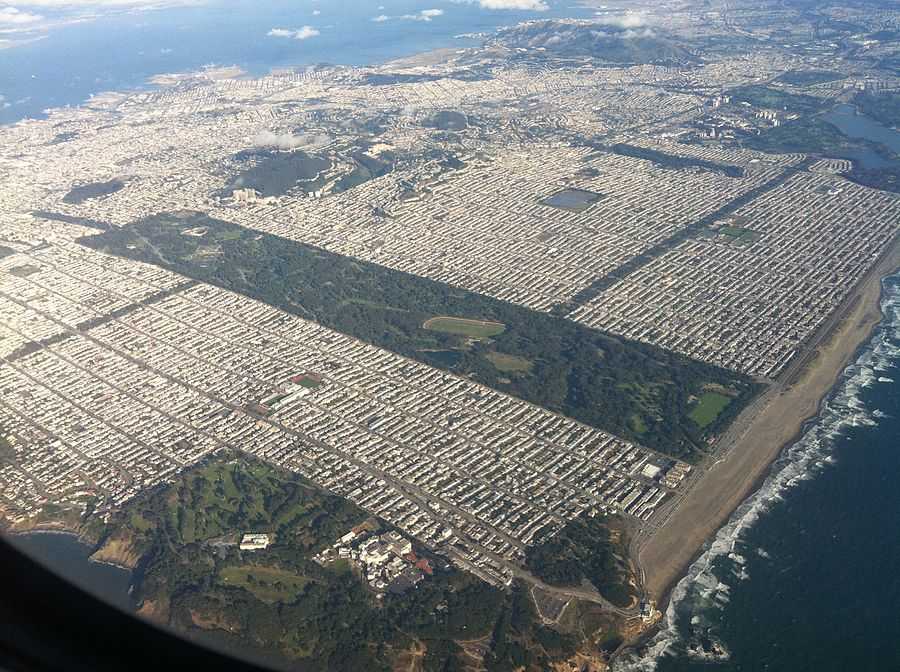




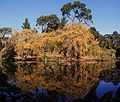


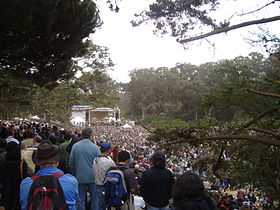


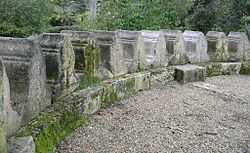





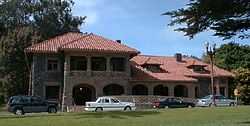
.svg.png)